

 = Award winner, nominee, or pick
= Award winner, nominee, or pick
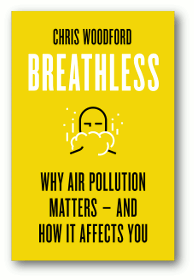
Date: 2021
Title: Breathless: Why Air Pollution Matters—And How it Affects You
An engaging introduction to the world's biggest, environmental, public-health problem, its causes, effects, and solutions, illustrated with simple charts and infographics, and featuring eye-opening air-quality tests around the home and beyond. The notes and references are now online, along with a bonus chapter called Angels with dirty faces: How air pollution blackens our buildings and monuments, which we cut from the book at the last minute to save space.
Publisher: Icon (English editions in the UK, Australia/New Zealand, Europe, India, South Africa). Foreign-language editions: Morning Star (Traditional Chinese), Editorial Pinolia (Spanish), Sumo/Ministry of Culture of Saudi Arabia (Arabic).
Edited by Hanna Milner.
Consultancy by Dr Jon Woodcock and Professor Peter Brimblecombe.
 The Independent: Books of the Month, March 2021.
The Independent: Books of the Month, March 2021.
“Breathless: Why Air Pollution Matters—and How it Affects You by Chris Woodford is one of our picks of the month #pollution.”
Martin Chilton, The Independent, March 2021.
“There are things he tells you that will absolutely appal you... it's really informative.”
Jo Good Show, BBC Radio London, 4 March 2021.
“... highly readable and entertaining (if sometimes frightening)”
Nick Smith, The Bay, March 2021.
“... a very useful and important book.”
Jeremy Williams, The Earthbound Report, March 2021.
“This is a fascinating, insightful and eye-opening read packed with research and statistics on how pollution can negatively affect our lifespan.... Highly recommended.”
The Book Doctor, Goodreads, March 2021.
“What an amazing book, rammed full of information and facts and figures that I'd never thought of. It's quite frightening when you read this book, what your body consumes.”
Susie F, NetGalley, March 2021.
“The enormous human and economic cost of the deadly fumes and tiny poisonous particles which fill our city streets barely registers as a political issue. However, a new book is about to change all that.”
Neil Mackay, The Herald, 21 March 2021.
“On the whole a really good book. Not too 'breathless' in his approach.... in fact rather measured and factual but the points made are very powerful. Happy to give it five stars.”
Booktsunami, Library Thing, 21 October 2021.
“Whether you are new to the topic or not, I wholeheartedly recommend this book.”
Jemima Hartshorn, activist and co-founder of Mums for Lungs.
“Well worth reading by Chris Woodford #AirPollution.”
Brian McHugh, Twitter, 9 January 2022.
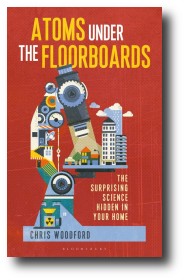
Date: 2015
Title: Atoms under the Floorboards: The Surprising Science Hidden in Your Home
A highly readable, whistle-stop tour of the home for armchair scientists.
Here's the latest version of the notes and references.
Publisher: Bloomsbury (most territories, with rights sold separately for Russia, China, Taiwan, Poland, South Korea, Italy, Germany, and Vietnam).
Edited by Jim Martin.
Consultancy by Dr Jon Woodcock.
Awards:
 The American Institute of Physics Science Writing Award for Books, 2016. (I donated the $3000 prize money
from this award to Cambridge University's Physics Outreach programme for schools.)
The American Institute of Physics Science Writing Award for Books, 2016. (I donated the $3000 prize money
from this award to Cambridge University's Physics Outreach programme for schools.)
 Physics World: Top Ten Physics Books 2015.
Physics World: Top Ten Physics Books 2015.
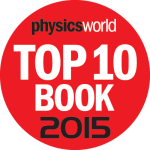
“The author's engaging narrative simplifies even the most complex of scientific phenomena to the point that anyone, from the person who hasn't been in a science class since high school to the PhD scientist, will be able to gain knowledge and enjoyment out of this book.”
John Kromer, Library Journal, May 2015.
“Science-writer Woodford wants you to know that seemingly ordinary things can hold quite interesting secrets... The author's writing is clear and precise; he explains complex matters simply, using scientific terminology without getting bogged down by it... With a lively, straightforward tone and high-interest topic, this will both amuse and fascinate teen science junkies.”
David Pitt, Booklist, May 15, 2015, Vol. 111, Issue 18.
“In this charming, informative book, Woodford (longtime science and technology writer) illustrates science, including chemistry, in a format with minimal math and suitable for a popular audience... Recommended. Lower-division undergraduates; students in technical programs; general readers.”
Choice, December 1, 2015.
“... an intriguingly different approach to home scientific ideas... presented in a lively and engrossing format perfect for any who like light, lively scientific discussions that take basic principles and trivia and examine them closely. The result is accessible not just to science readers, but for any interested in how home technology actually works—and doesn't work..”
California Bookwatch (Midwest Book Review), August 2015.
“In a mere 300 pages or so, 'Atoms Under the Floorboards' provides elegant answers to questions so obvious it's likely you've never thought of them... plenty here to interest those curious about the scientific underpinnings of the modern world.”
William Gurstelle, Wall Street Journal, June 2015.
“Chris Woodford's book stands out, both for its clarity and for the unusual phenomena he explains... Each short chapter contains gems of lucid, accessible science writing... Atoms Under the Floorboards is so well written that one can happily read it from cover to cover... both enjoyable and informative.”
Cary Seidman, NSTA Recommends, 17 July 2015.
“Mostly the result is phenomenal... a fun, light hearted science book that you could give to a teenager, or the sort of person who doesn't really read popular science but would like to find out a bit more about the scientific world around them - and I think they'll have a good time.”
Brian Clegg, Popularscience.co.uk, March 2015.
“... many delights in this fun and accessible book, which is written for a general audience... The best part of the book, though, is the sense of imagination it brings to everyday phenomena.”
Margaret Harris, Physics World, August 2015.
“The reader is bound to get puzzled at first, then intrigued and ultimately hooked as the book hurtles past theories in physics and biology as well as civil, mechanical, chemical and electrical engineering... Read this book to reawaken your curiosity.”
Debarghya Sanyal, Business Standard (India), July 2015.
“This book entertains the reader with all the interesting facts of science related to the boring life around you.”
Deccan Herald (India), June 2015.
“Written in a lucid and interactive style, the book is fun to read and a mine of knowledge—one that promises to change the way you or your kids look at the smallest of things in daily life.”
The Times of India, October 2015.
“... vastly informative... does explain some astonishing things.”
Vivien Horler, Cape Argus (South Africa), July 2015.
“... the book that should be given to every high school science teacher as curriculum support... the most accessible and enjoyable tour through the average house and the stuff found inside it... a pleasure to read good science clearly demystified.”
Sue Townsend, Cape Times (South Africa), 17 July 2015.
“... a brilliant read for any enthusiastic young scientists, or perhaps secondary-school science teachers looking for some creative analogies to help explain difficult concepts... For anyone wanting a fresh perspective and some detailed insight into even the most seemingly mundane of objects, it's a must-read.”
Jamie Durrani, Chemistry World (Royal Society of Chemistry), 8 June 2016.
“Each chapter offers fun, comprehensive facts about how things work the way they do.”
Andreea Ciulac, Chicago Tribune, 30 July 2016.
“...accessible, eloquent discussion of a variety of science topics using phenomena of our homes or everyday lives... [an] excellent example of science writing for the public.”
The American Institute of Physics Science Writing Award for Books, 6 October 2016.
“This wonderful introduction takes you on a journey into the science hidden in your home.... A surprisingly enjoyable read.”
Patrick Gane, The Sun, 27 March 2015, p.60.
“Woodford's work offers the reader fascinating scientific explanations of familiar things, from creaking floorboards to snapping rubber bands to gurgling sinks and snoring people. A book that is absolutely worth reading for anyone who wants to understand the physical background of their environment.”
Christina Rohrbach, Solinger Tageblatt, 22 November 2017.
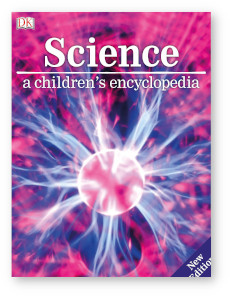
Date: 2018/2016/2014
Title: Science: A Children's Encyclopedia
Engaging 304-page general science book, now in its third major edition.
Publisher: Dorling Kindersley/Penguin
Co-written with Steve Parker.
Edited by Daniel Mills.
Currently scoring 4.7/4.8 on Amazon with 545 (mostly happy) reviews (UK and US editions combined).
“If you're looking for general science primer to help with school work, or just to inspire inquisitive minds, it's hard to imagine you'll find a better one than this.”
Robin Brooks, Geek Dad, 5 September 2018.
“A wide-ranging and engaging look at many areas of science, great discoveries, and scientists. Written by Chris Woodford and Steve Parker, this encyclopedia is great for 7- to 12-year-olds.”
T.J. Resler, How Things Work, National Geographic Kids, 2016.
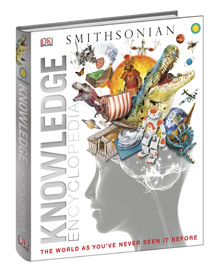
Date: 2013
Title: DK Smithsonian Knowledge Encyclopedia
Visually engaging family encyclopedia jointly produced by DK and The Smithsonian.
Publisher: Dorling Kindersley
Writer of the science section, edited by Sam Priddy.
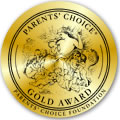
 Awards:
Parents' Choice Gold Award 2014.
Awards:
Parents' Choice Gold Award 2014.
“...mesmerizing compendium... page after page of graphically compelling, compact explanations of things you'll never see coming..."”
Dan Oldenburg, Parents' Choice, Spring 2014.
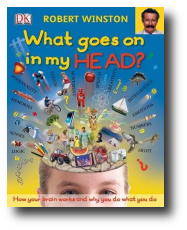
Date: 2010
Title: What goes on in my head? by Robert Winston
Publisher: Dorling Kindersley.
Edited by Ben Morgan.
Contributor.
Book for children aged 9-12.
 Awards:
Shortlisted: Royal Society Young People's Book Prize, 2011.
Awards:
Shortlisted: Royal Society Young People's Book Prize, 2011.
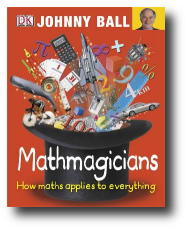
Date: 2009
Title: Mathmagicians by Johnny Ball
Publisher: Worldwide: Dorling Kindersley.
Edited by Ben Morgan.
Consultant and contributor.
96-page book for ages 8+
 Awards: Teachers' Choice Award for Children's Books (2011).
Awards: Teachers' Choice Award for Children's Books (2011).
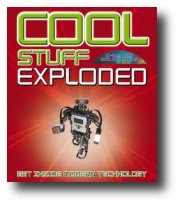
Date: 2008
Title: Cool Stuff Exploded
A dazzling, colourful look inside mean machines, fast cars, and other cool stuff.
Publisher: Worldwide: Dorling Kindersley and co-publishers
256-page book for ages 8+
Consultancy by Dr Jon Woodcock.
Edited by Victoria Heyworth-Dunne.
 Awards: National Science Teachers Association/CBC Outstanding Science Trade Book for 2009.
Awards: National Science Teachers Association/CBC Outstanding Science Trade Book for 2009.
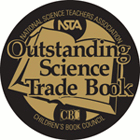
“...a huge book that's likely to become a classroom favorite for students of any age... Engineering has never been so exciting!”
National Science Teachers Association, January, 2009.
“Inspiring stuff for the budding scientist.”
TES, September 25, 2008.
“As usual with DK books, the coolness factor is augmented by, and in no way disturbed by, lots and lots of information... I wish I'd taken a picture of my (seven-year-old) son's face when he first opened the book—his eyes widened and he grinned. He sat down and read at least twenty pages right away, and he's gone back to it many times.”
Matt Blum, WIRED, September 29, 2008.
“Lavish photography and computer graphics aid Chris Woodford as he takes apart some of the 20th century's greatest inventions... a stunning reminder of the ingenuity behind innovations we all too often take for granted.”
David Robson, New Scientist, December, 2008.
“For parents frustrated by sons who prefer video games to literature. With easy-to-understand, chunk-sized bits of text and an explosion of pictures and graphics, the author explains secrets hidden inside machines. From helicopters to washing machines, the book blows apart the whole to show the pieces that make them work. A Pendolino train that tilts around curves is displayed on four fold-out pages, as is the European Ariane 5 rocket. Awesome facts. Cool reading.”
The Globe and Mail, Toronto, December, 2008.
“...informative and engaging text...”
Laurinda Motion, Reading Time, Children's Book Council of Australia, May 2009.
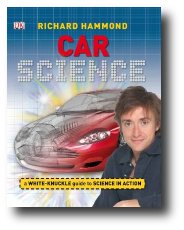
Date: 2008
Title: Car Science by Richard Hammond
"A turbo-charged tour through the nuts and bolts of car technology."
Publisher: Dorling Kindersley
Edited by Ben Morgan.
Consultant and contributor
96-page book for ages 8+
Awards:
 National Science Teachers Association/CBC Outstanding Science Trade Book for 2009.
National Science Teachers Association/CBC Outstanding Science Trade Book for 2009.
 Finalist: Children's Choice Book Awards, 2008.
Finalist: Children's Choice Book Awards, 2008.

“...a comprehensive analysis of every aspect of the automobile and the scientific principles that make every part work. Clear explanations coupled with excellent illustrations make the car into more than just a vehicle—it is an everyday science project that students will embrace... a treasure of clear illustration, historical background, and explanation... any child who likes automobiles will be captivated by Car Science.”
National Science Teachers Association, November, 2008.
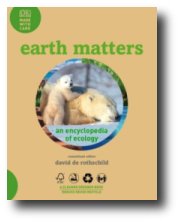
Date: 2008
Title: Earth Matters
A glossy, global look at environmental issues for younger children.
Edited by Ben Morgan.
Publisher: Worldwide: Dorling Kindersley and co-publishers
256-page book for ages 8+
Awards:
 Geographical Association Awards, Highly Commended, 2009.
Geographical Association Awards, Highly Commended, 2009.
 Sunday Times Children's Book of the Week, April 27, 2008.
Sunday Times Children's Book of the Week, April 27, 2008.
 Parents' Choice Gold Award in Nonfiction category (2008)
Parents' Choice Gold Award in Nonfiction category (2008)
 SSLI Honor Book Science K-6 (2008)
SSLI Honor Book Science K-6 (2008)
 2009 Santa Monica Public Library Green Prize for Sustainable Literature
2009 Santa Monica Public Library Green Prize for Sustainable Literature
 Shortlisted: 2008 British Book Design and Production Awards 2008
Shortlisted: 2008 British Book Design and Production Awards 2008
“The book is clearly intended to be a campaigning book and this refreshing honesty is one of its strengths. Earth Matters is very attractive and informative, with stunning photographs and up-to-date data. It is likely to interest young people and capture their imaginations. This encyclopaedia is beautifully produced and young people will enjoy using it.”
Geographical Association Awards, 2009.
“This book is both a clarion call to help the environment, and an encyclopaedia of the natural world. It is also a beautiful object... although the catalogue of damage caused by climate change is alarming, the information... is so engaging that the effect is not to deter but to inspire.”
Sunday Times, April 27, 2008.
“This 'family encyclopedia of ecology' is filled with gorgeous photographs, and its layouts, typefaces and bright colors are worthy of a high-end fashion magazine... If your child is prone to melancholy, you might want to keep this book hidden until he's ready to cope. But if he enjoys a challenge, don't hold back.”
Elizabeth Royte, New York Times, Sunday Book Review, May 11, 2008.
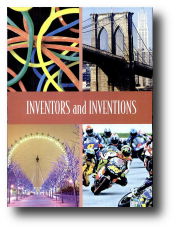
Date: 2007
Title: Inventors and Inventions
Encyclopedia set for middle-schools.
Edited by Hilary W. Poole.
Publisher: Marshall Cavendish
Major contributor: over 180,000 words across five-volumes
1600-page science and technology set.
 Awards:
Chosen as one of the Twenty Best Bets for Student Researchers, Booklist, 2008.
Awards:
Chosen as one of the Twenty Best Bets for Student Researchers, Booklist, 2008.
“...highly readable and engaging text... a valuable reference for students and browsers alike.”
Booklist, March 2008.
“Some accounts of these inventions can be found in other sources, but none are as inclusive and thorough as this one.”
School Library Journal, February 2008.
“Although many of the inventors are included in standard biographical sources, these articles are broader and more comprehensive...”
Library Journal, January 2008.
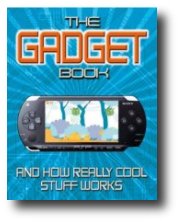
Date: 2007
Title: The Gadget Book and How Really Cool Stuff Works (Published in the US and other countries as: Cool Stuff 2.0)
Follow-up to Cool Stuff and How it works. Co-written with Jon Woodcock.
Edited by Julie Ferris.
Publisher: Dorling Kindersley
Awards:
 VOYA Nonfiction Honor List Award.
VOYA Nonfiction Honor List Award.
 Young Adults' Choices 2009.
Young Adults' Choices 2009.
“Science takes center stage in Cool Stuff 2.0 and How It Works. In this photo-filled book, kids get an inside look at a toilet whose high-tech water nozzle and air drying system eliminate the need for toilet paper, a bed that relies on magnetism to float in the air, and the 'vomit comet' used by NASA to accustom astronauts to the nausea-inducing effects of weightlessness. Authors Chris Woodford and Jon Woodcock give each topic a two-page spread filled with short bursts of facts. Some of the items in this snazzily covered book, like the 'petcam,' are frivolous; others—such as the LifeStraw, a device that filters impure water as a person sucks it in—offer hope for developing countries.”
Karen MacPherson, The Washington Post, December 2007.
“5 out of 5. This is a great book. It has amazing gadgets that I had never even heard of or thought about and explains all about them in detail. I would recommend this book to anyone, especially gadget lovers. This book is gadget lovers heaven. I will let you find out for yourselves what gadgets it has but overall this is a fantastic book!!!”
Amazon.co.uk customer review, January 2008.
“4 out of 5. A very good book. The pictures were stunning, and the text provided information in a way which was easy to understand. The boxes entitled 'How it works' were fantastic, with incredible cross section diagrams showing you how all of your favorite gadgets work. If you like gadgets, you will LOVE this book!”
Remy Osman, review posted to DK website, January 2008.
“For the hippest technophiles comes Cool Stuff 2.0... Full-bleed color photography and illustrations make an equally compelling counterpoint to the scientific explanations.”
Publishers Weekly.
“This is a great book to explore the future in objects that are here today.”
Young Adults' Choices 2009, Journal of Adolescent & Adult Literacy, November 2009.
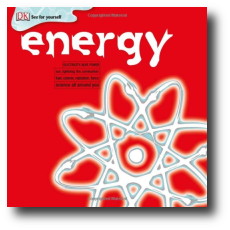
Date: 2007
Title: Energy
Publisher: Dorling Kindersley
Edited by Niki Foreman.
Consultancy by Dr Jon Woodcock.
A highly colourful 64-page introduction to energy for 10+ readers.
“...covers just about everything middle-graders might want to know about energy... excellent, four-page centerfold explaining the energy cycle... A worthwhile addition to most collections.”
Booklist, April 1, 2007.
“...invaluable information.”
Publishers Weekly, Volume 254 Issue 20, May 14, 2007.
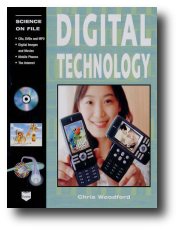
Date: 2006
Title: Digital Technology
Publisher: Evans Brothers
Edited by Steve Parker.
48-page book for children aged 11-14
“...a dream checkout for technology lovers and a welcome introduction to young patrons who are not yet tech literate but would like to be... clear and comprehensible... Packed with diverse and interesting bits of information that is divided into manageably small chunks... much to consider, digest, and relish.”
Booklist, 2007.

Date: 2006
Title: Can you feel the force? by Richard Hammond
Publisher: Dorling Kindersley
Edited by Ben Morgan.
Consultant and contributor
96-page physics book.
 Awards:
Winner: Royal Society Junior Prize for Science Books, 2007.
Awards:
Winner: Royal Society Junior Prize for Science Books, 2007.
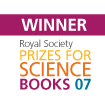
“Commenting on Can you feel the Force?, Anna aged 13 and one of the Junior Judges said: 'It was good because it had unusual facts that you wouldn't know from science lessons.'
Andrew aged 11 said: 'The illustrations were good but my favourite bit was the way of walking on custard.'
Adele aged 11 said: 'I didn't vote for it just because Richard Hammond wrote it, it truly was the best.'
Eleanor Updale, chair of the junior judging panels said: 'This instantly appealing book traces the roots of physics to the dawn of civilization, but concentrates on the way physical forces are at work in all our lives today. With clear illustrations, practical experiments, and well-paced text, it makes an interest in science look like fun and above all, normal.'”
Royal Society Press Release, May 2007.
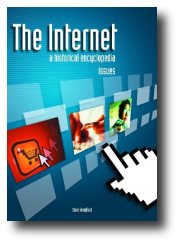
Date: 2005
Title: The Internet: A Historical Encyclopedia: Issues
Publisher: USA: ABC Clio
Edited by Hilary W. Poole.
150,000-word volume about the Internet's social impacts
“...very interesting reading—a great reference source.”
Communication Booknotes Quarterly, Winter 2006.
“The stated goal of... [this volume]... is to provide a broad social and historical picture so the reader may better appreciate both advancements and problems associated with the growth of a new technology—similar to the way one steps back to admire a work of art. The volume does manage to effectively paint a broad picture of issues. Some example topics include copyright, the digital divide, information warfare, and taxation. A reader could, in fact, sit down and read this volume cover to cover and come away with a well-rounded view of the effect the Internet has had, and will continue to have, on society...Highly recommended...”
Aimée deChambeau, Reference & User Services Quarterly, Summer 2006.
“...lively, accessible articles on the development of popular Internet trends and personalities.”
CHOICE, September 2006.
“...packs in plenty of solid material and will have wide appeal for students in middle school and above, but also for curious adults who want to fill some gaps in their general knowledge.”
SciTech Book News.
“...valuable information for students and general readers doing research on the Internet and the impact it has had on our world. It is recommended for public, community college, and academic libraries.”
American Reference Books Annual.
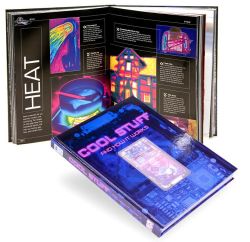
Date: 2005
Title: How Cool Stuff Works
Publisher: Worldwide: Dorling Kindersley and co-publishers
I wrote half the book; the rest was written by Ben Morgan, James Flint, Clint Witchalls, Luke Collins, and the editors.
Edited by Fran Jones and Carey Scott.
256-page technology book for ages 8+
Over 3.6 million copies sold worldwide—and the paperback still creeps back into the Amazon top 2000 each Christmas.
Awards:
 Recommended, Parents' Choice, 2005.
Recommended, Parents' Choice, 2005.
 Finalist in the AAAS/Subaru Science Books & Films Excellence in Science Books Prize, 2007.
Finalist in the AAAS/Subaru Science Books & Films Excellence in Science Books Prize, 2007.
“A fascinating, thorough look at modern technology.”
Library Media Connection.
“More random information – this time for tech-heads and schoolboys who really, really want to know what makes modern technology tick. The editors explain the imaging techniques used to illustrate this visually hellzapoppin book – macrophotography, Doppler radar, ultrasound, X-rays, magnetic resonance, exploded view and the rest. The science is sound and simple – verbal exposition is minimal, visuals are taken to the max to deconstruct everyday stuff that we take for granted: iPods, flash sticks, antibiotics, aerosols. The editors have seen the future and it's in high-tech colour.”
The Times, October 2005, p.10.
“Forget the pretty-looking DK books of yesteryear, this is designed to blow your mind... This is an attention-grabbing way of getting technology-loving children to pick up a real book. Cool? You'd better believe it!”
Philip Ardagh , The Guardian, October 2005.
“You only have to read the title and see the cover image of an iPod that turns transparent so you can see its innards when you tilt the book to realize that this is going to be an appealing read... combines text and striking graphic imagery - some of the best we've seen in a DK book, and that's saying something - that explore one piece of technology... a good opportunity to open up science and technology through the route of the appeal of the machine... It's definitely cool..”
Popular Science, October 2005.
“Cool stuff for cool kids! Flip to the facts on today's technology from iPods to mobile phones, and find out how they really work. With incredible detail and eye-popping photographs, this is the low-down on today's technology and tomorrow's gadgets. !”
Francesca Simon, The Guardian, 1 October 2005, p.10.
“...one of the most aptly named books ever... a team of writers with a marvelous knack for explaining technical concepts in an accessible manner. Cool Stuff is divided into six chapters exploring themes ranging from "Connect" (cell phones, fiber optics, pet translators) and "Move" (submersibles, black boxes, space shuttle) to "Survive" (laser surgery, bionic limbs, bio chips). The writers frequently draw connections between technology and nature, mentioning the bioluminescence of fireflies and jellyfish in a discussion of neon, for example. They also highlight new spins on "old" tech devices—a digital pen, a Swiss Army knife/flash memory drive. These colorful pages are packed with diagrams, images and text boxes, perfect for the way today's kids process information. The book uses scanning imagery—colored X-rays, MRI and thermal—to show the inner structure of such things as an electric guitar, an MP3 player, a washing machine and even a head listening to headphones. Cool Stuff would make the perfect gift for the kid in your life who likes to dismantle household gadgets and try to put them back together (not always successfully).”
BookPage Children's Review: Gift Roundup, December 2005.
“This will rate high on the 'cool' factor, whether at home, school, or library.”
David Siegfried, Booklist, American Library Association, December 2005.
“...an invaluable illustrated guide for every technophile (and, even more, technophobe) to the innards of computers, aircraft, mobiles, MP3s, microwaves, antibiotics, and so irresistibly on..”
Independent, December 2005.
“This is a book for 21st Century kid who are curious about everything. It's essentially a book about how cool stuff works but with a very important difference for young readers. Cool Stuff and How It Works utilizes diagrams far better than most books of its kind, striking an excellent balance between pictures and text. This feature is worth mentioning. Too many general interest explanation books are so much like textbooks they turn kids off.”
Parents' Choice, 2005.
“One of the most fascinating DK books in print. A must have for every library and school, not to mention home library.”
The Rebecca Review, June 2006.
“Well written explanations of everyday phenomenon, from cell phones to surgery.”
Leonard J. Sedlacek, Amazon.com customer review, February 2006.
“From iPods to medicine, washing machines to motorized wheelchairs, and scanners to flash sticks, the latest modern technological innovations are reviewed in a vivid survey of the science behind the invention. The latest devices present in our daily lives, from solar cells and microwaves to compact discs, are surveyed in lively, photo-packed chapters which include plenty of colorful visual powers, diagrams, cut-aways and scientific detail to intrigue grades 6-9.”
Midwest Book Review, January 2006.
“Teens who enjoy taking "stuff" apart in order to find out how it works will spend hours poring over this eyeopening book. The book's carefully worded descriptions, colorful graphics, and clear fonts and line spacing help the reader more easily understand today's modern tools.”
Science, December 8, 2006.
“Does exactly what it says on the cover! Not just a book for kids, this book is fascinating... 4 out of 5”
Carol Begley, Waterstone's London Science Museum.
“5 out of 5 stars: Excellent reference book. This book is great. It covers everything from how mobile phones work to scanners in shops. Very factual in a fun and cool way. My son loves it! It is also educating his parents!!”
Amazon customer review, March 2009.
“5 out of 5 stars: How to Fascinate a Seven-Year-Old. Bought for my grandson's seventh birthday, this book has not yet reached his bookshelves as it is constantly in use. For any child with an enquiring mind and a fascination for finding out how things work, this is an excellent choice.”
Amazon customer review, July 2009.
“A great book to read with a curious child.”
Globe & Mail, Toronto, 12 Dec. 2009, p. F14.
“...an invaluable illustrated guide for every technophile (and, even more, technophobe) to the innards of computers, aircraft, mobiles, MP3s, microwaves, antibiotics, and so irresistibly on.”
Boyd Tonkin, The Independent, December 2005.
“The perfect gift for a techy teenager.”
Anne Johnstone, The Herald, December 2005, p.7.
“... great new book answers all the questions you're ever likely to be asked... a fab family read for anyone over the age of 10... every fact explained in a fun and accessible way.”
Janet Tansley, Liverpool Echo, August 2005.

Date: 2005
Title: How do we measure...
Eight 30-page books for children aged 7-9 (grades 4-6) covering basic maths topics (area, speed, temperature, weight, distance, height, time, and volume).
Edited by Bridget Giles.
Publisher: USA: Blackbirch
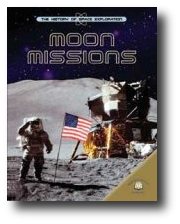
Date: 2004
Title: Moon Missions
Publisher: USA: Gareth Stevens/World Almanac
Book for children age 10+, grades 5+
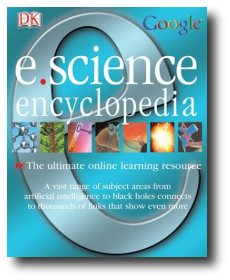
Date: 2004
Title: DK Google E-Science Encyclopedia
Publisher: Worldwide: Dorling Kindersley/Google
60-page section on Forces and Energy, Light and Sound for UK National Curriculum science KS2-3; linked website.
 Awards:
Shortlisted: Children's Trade category, British Book Design and Production Awards Book of the Year.
Awards:
Shortlisted: Children's Trade category, British Book Design and Production Awards Book of the Year.
“This has to be one of the most beautiful books DK has ever created. The colors are vibrant... Every section has a bold heading and interesting definition. Then, there are pages and pages of full-color pictures that can keep your attention for hours at a time. I wish we had owned a book like this when I was a child because it would have given me an information base to build on in future years. Although I must say, I think adults will find this equally fascinating. Children are always asking questions and now you can find all the answers, complete with pictures... Fascinating Pictures...”
Amazon.com customer review, October 2004.
“I bought this Science Encyclopedia along with their basic Encyclopedia and I truly love it. My kids are always reading it whenever they get the chance. I have a 5 minute session after lunch before my class leaves to go to "specials." During that 5 minute teaching period I have been letting them pick out one subject area from one of the encyclopedias and then we review how to read nonfiction while looking over that subject briefly. I am amazed to see the sparks that start flying and how interested in all of the subjects the students have been. The pictures are wonderful and help students to connect with the information they are reading. I will buy more sets for my classroom because they are always in use!!!!”
Amazon.com customer review, February 2005.
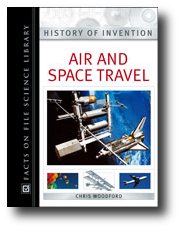
Date: 2004
Title: Air and Space Travel, Ships and Submarines, Power and Energy, Communications and Computers
Publisher: USA: Facts on File
Edited by Tom Jackson.
Four 20,000-word volumes on the history of modern technology.
 Recommended reading, Cobblestone, Vol. 33, Issue 2.
Recommended reading, Cobblestone, Vol. 33, Issue 2.
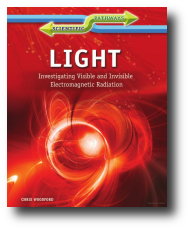
Date: 2004
Title: Routes of Science: Electricity
Publisher: USA: Blackbirch
Series of four books for children aged 9-11 covering electricity, light and radiation, gravity, and atoms and molecules (co-authored with Martin Clowes).
“...excellent supplements to the science curriculum.”
School Library Journal, The Book Review, May 2005.
“The cream of the crop of children's science books... one would be hard pressed to find a better all-in-one introduction to the elementary constituents of matter than Chris Woodford and Martin Clowes' Atoms and Molecules (Brown Reference Group, 2004).”
The Age, Australia, 2004.
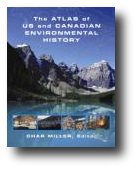
Date: 2003
Title: Atlas of US and Canadian Environmental History
Publisher: USA and UK: Routledge
Writing 12 articles on contemporary and historical environmental issues.
Edited by: Professor F. Char Miller, University of Texas.
 Awards:
Pennsylvania School Librarians Association Best Reference Titles 2003
Awards:
Pennsylvania School Librarians Association Best Reference Titles 2003
“Lavishly illustrated... Highly recommended for young adult and adult collections.”
Pennsylvania School Librarians Association, 2003.
“Written in clear and accessible language with superb illustrative material in vivid color, this unique resource is recommended for public, academic, and high school students in history and environmental studies.”
Library Journal, September 2003.
“This provocative approach to North American history and public policy will serve high school, college and public library users.”
Gale Reference Reviews, October 2003.
“[The contributors] have certainly done a fine job.... Recommended for high-school, public, and academic libraries.”
Booklist/RBB
“A highly useful volume... this comprehensive work is an excellent resource...”
School Library Journal, December 2003.
“Well-written... The articles... all offer essential insights and are objective and carefully documented... Lavishly illustrated...[Includes] fascinating sidebars... outstanding addition to environmental history... Highly recommended. All readership levels.”
Choice, January 2004.
“Offers essays written by history scholars on ecological issue for young adults... Entries on water rights, forestry, and agriculture are invaluable. These controversial topics are explained in a simple, nonbiased way that will appeal to young adults. The statistics offered are frequently enlightening…. Librarians whose patrons are interested in environmental research, particularly in the western United States and Canada, will want to include this volume in their collection”
VOYA.
“The most useful resource book that the field of environmental history has yet created. Combining exceptional vivid maps with relevant visuals, each well-focused essay is a gold mine of information... It is a volume that each environmental professional and educator should make certain is contained in his or her library. This is the environmental history book that every Environmental Studies program should have in its library or available to its students in the program's library. It will mark an excellent starting point for student research projects... The Atlas stands out as a tremendous resource for even the general readers and researcher. For environmental historians and professionals, this volume should become the first stop for finding quick answers or details, whether one is preparing a lecture, a political document, or beginning a research paper. Char Miller has performed a superb service to the field.”
Environmental History

Date: 2003
Title: Interdisciplinary Encyclopedia of Marine Sciences
Publisher: USA: Grolier
Writing 29 articles on oceanographic and environmental topics.
Edited by: Professor James Nybakken, Moss Landing Marine Laboratories.
 Awards: Choice:
Outstanding Academic Title, 2003.
Awards: Choice:
Outstanding Academic Title, 2003.
“Written in a non-technical, easy-to-understand language, it is a benchmark work that will be an indispensable addition to libraries of high schools, colleges, and universities.”
John S. Pearse, Professor of Biology, University of California, Santa Cruz President, California Academy of Sciences
“...far more extensive than most one-volume sources... Essential for all undergraduate programs supporting coursework in marine sciences and oceanography.”
Choice
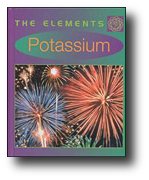
Date: 2002
Title: The Elements: Potassium/Titanium
Publisher: USA: Benchmark Books/Marshall Cavendish
Basic introductions to the chemical elements potassium and titanium for children aged 10-12.
“These books are a good introduction to each of these chemical elements and their impact on our world. All would be fine additions to an elementary or middle school library.”
Science Books & Films, May/June 2003
“Readable overviews of these elements. Explanations are succinct and clear, without being oversimplified, and supplemental information is provided in boxed sidebars. Relevant diagrams, drawings, and photographs, mainly in color, appear on every page. Each book covers the element's history, where it is found, and how it is extracted and purified, as well as how it is used and its chemical reactions.... Potassium details the element's importance in soaps and explosives, and in the human body. The large, bold text will appeal to younger readers, and the explanations and visuals provided for specific chemical reactions are especially helpful. In addition, each book has a spread devoted to the periodic table and element's particular place in it. Good choices for reports.”
School Library Journal, April 2003
“Information about the scientific elements for middle-graders is always welcome. This series organizes each book to provide all the facts that could possibly be called for in a research report (what the element is, characteristics, habitat, uses, importance) concluding with an illustration of the periodic table and the specific element's place in it. The colorful photographs, illustrations, and fact boxes bring to life what could have been a dull subject. Very readable in the page layouts, these books present accessible information in a fresh, bright way. These will prove to be the most popular items on the subject. Look for the other books in this series. Recommended.”
Library Media Connection, April/May 2003
“The interesting blend of science, art, geography, and history makes this volume a great resource for an interdisciplinary curriculum.”
NSTA (National Science Teachers Association) Recommends, June 2003
“The Elements: Titanium quickly engages readers with relevant information, beautiful photos, and fascinating facts... Many educators have pointed to a need for more authentic, descriptive chemistry in the content offered to middle and secondary students. These books clearly address that need, so teachers of chemistry or physical science may want the entire series. These books would be great reference sources or books for informational reading.”
The Science Teacher, NSTA (National Science Teachers Association) Recommends, June 2003, p.98.
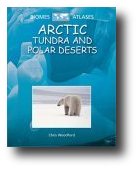
Date: 2002
Title: Arctic Tundra and Polar Deserts (Biomes Atlases)
Publisher: USA: Raintree Steck Vaughn; UK: Heinemann
Edited by Ben Morgan.
Book for children aged 9-11.
“Recommended. This series uses exquisite, captioned photographs and informative text to depict the beauty and the dangers that exist within a given biome.”
Library Talk
“This is a very interesting book which covers quite a wide range of information about these regions. Maps are included with detail information on the sidebar and numbered references on the map. Photographs are specific and beautiful showing telephoto shots of many animals and plants. After reading this book, one can understand these regions much better. This is a good book for research on the areas as well. Recommendation: Highly Recommended.”
Lynette Morgan, Library Media Specialist, Arapaho School, March 2003.
“This volume introduces readers to the Arctic tundra and polar deserts biomes, exploring the relationship between climate, geography, plants and people that define these places on Earth. Perhaps because of the scarcity of plant and animal life in the polar desert areas, most biomes books don't recognize it at all, listing tundra as the coldest biomes, thus making the information in this book more invaluable... The text is accurate, fairly well written, and augmented by many interesting story/fact file boxes. True to the series title, the book contains many varied and informative maps, often with numbered keyed captions that provide the reader with added facts and important places. There are many beautiful, well-chosen and well-reproduced photographs. The book concludes with a useful glossary, a short bibliography, and an index. Although not perhaps a necessary purchase, this book would be a very good addition to libraries needing more updated information on this subject”
Highlands Regional Library Cooperative
“...sold outstandingly well internationally....”
Ashley Brown, Chairman, Brown Reference Group
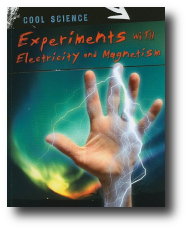
Date: 2002
Title: Science Activities: Sound and Hearing, Science Activities: Electricity and Magnetism
Publisher: USA: Grolier/Gareth Stevens
Two books of science experiments for children aged 9-13.
“These volumes offer a comprehensive and concise approach to science subjects and experiments. The scope, presentation, and design of this set make it a solid reference tool.”
School Library Journal, November 2002.
“An exemplary set of books that will be of value to middle school students, elementary and middle school teachers and motivated parents who want to do science investigations at home with their children... In sum, high praise for this set of science books!”
Science Books & Films, September/October 2002.
“Recommended.”
The Book Report, November/December 2002.
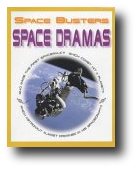
Date: 2002
Title: Space Dramas
Publisher: UK: Belitha Press; USA: Raintree Steck Vaughn; Denmark: Flachs
Book for children aged 7-9 (reluctant readers).
“The Space Busters series is unique. These books provide greater depth of coverage than most informational books for elementary students, while maintaining readability and interest. The text, informative without being overwhelming, is supported by amazing photographs and drawings. Each book starts with a history of its specific topic, discusses current issues, and ends with possible future scenarios. Space Dramas features stories of problems encountered during space exploration, most of which ended well. The book does not dwell on deaths, and handles tragedy tactfully. My second graders loved this series, and this was their favorite book. Average second grade readers will have no trouble with the text, but the good glossary will help less able readers. This book would be great to support discussions of the challenges and costs of space exploration.”
Stephanie Hogle, 1st and 2nd grade teacher, The Science Teacher, NSTA (National Science Teachers Association) Recommends, Nov/Dec 2003, p.52.
“The massive explosions and spectacular failures in Dramas... will widen the eyes of even hardened disaster fans.”
John Peters, New York Public Library.

Date: 2002
Title: World at Risk: A Global Issues Sourcebook
Publisher: USA: Congressional Quarterly Press, Washington, D.C.
Edited by Valerie Tomaselli.
Writing 5 chapters of approx. 10,000 words on contemporary environmental issues.
 Awards: Choice:
Outstanding Academic Title, 2002.
Awards: Choice:
Outstanding Academic Title, 2002.
“Like all CQ's publications, this work is characterized by analytical excellence. Recommended for all reference collections.”
Choice, December 2002.
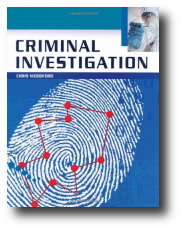
Date: 2001
Title: Science Fact Files: Criminal Investigation
Publisher: UK: Hodder Wayland; USA: Raintree Steck Vaughn
Book for children, KS3 science. Hardback and paperback editions.
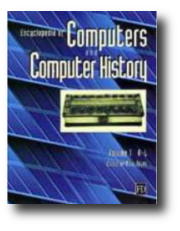
Date: 2001
Title: Encyclopedia of Computers and Computer History
Publisher: USA and UK: Fitzroy Dearborn
Major contributor. Writing 45 articles.
Edited by: Professor Raúl Rojas, Free University of Berlin.
Awards:
 American
Library Association: Outstanding Reference Source
American
Library Association: Outstanding Reference Source
 Choice:
Outstanding Academic Book, 2001
Choice:
Outstanding Academic Book, 2001
“An introduction to computers and computer history that has been sorely missing from reference shelves. Essential for undergraduate collections, academic and public libraries.”
Choice.
“There are some good factual articles, such as Chris Woodford's pieces on Wired magazine and Netscape Communications.”
Times Higher Educational Supplement, February 8, 2002.
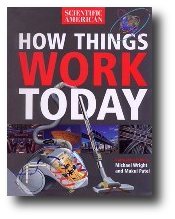
Date: 2000
Title: Scientific American: How Things Work Today
Publisher: UK: Marshall Editions USA: Crown/Random House. Rights sold worldwide.
Edited by Paul Docherty.
Writing approx. 20 articles, including four long features on materials science.
“...packed with information on modern science and technology and an excellent reference book for all the family”
Parents Online
“an excellent guide”
Amazon.com editorial review.
“amazingly well written”
Amazon.com customer review.
“I have had a blast reading through this book, and have learned more practical knowledge from it than any other that I can remember.... I truly loved this book. It is a great feeling to have a basic understanding of how nearly everything we use works. You will never look at an escalator in the sameway! This book would make an excellent gift!”
Amazon.com customer review.
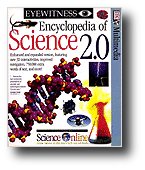
Date: 1997
Title: Eyewitness Encyclopedia of Science 2.0 CD-ROM
Publisher: USA and UK: Dorling Kindersley
Writing and editing physics text articles, multimedia authoring and testing.
 Awards: ASCD
"Only the Best" Alert to New Programs 1996
Awards: ASCD
"Only the Best" Alert to New Programs 1996
 Awards: SIGCAT
1995 Significant Achievement Award in Secondary Education.
Awards: SIGCAT
1995 Significant Achievement Award in Secondary Education.
“Dorling Kindersley's releases never fail to dazzle...but for Eyewitness Encyclopedia of Science, DK has pulled out all available stops, and a few more besides.”
PC-Guide.
“A uniquely absorbing experience...the superb design means that you never get lost...We have never awarded a five-star rating to any disc before; it's possible we never will again... A work of genius.”
CD-ROM Today.
“Brilliantly put together and lots of fun to explore.”
The Guardian.
“The vast amount of information on offer is astounding... another fine reference title.”
PC Format.
“Dorling Kindersley specialists in such things, and at their best they come dangerously near to convincing the user that 'science is fun'.”The Economist, Vol. 337, Issue 7940, November 1995.